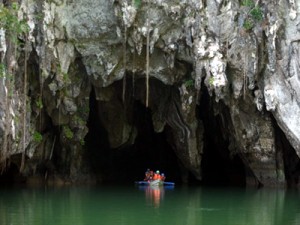Puerto Princesa Underground River now one of world’s protected wetlands
PUERTO PRINCESA CITY—The city’s famed subterranean River National Park was installed Tuesday as one of the world’s protected areas of biodiversity under the Ramsar Convention, an international treaty aimed at conserving wetlands.
At installation rites Tuesday, Mayor Edward Hagedorn was excited about the province’s tourism prospects, saying Puerto Princesa had already overtaken popular resort island Boracay in terms of visitors this year. But he added that in line with the city’s commitment’s under the convention, he would have to limit visitors to the underground river to 900 a day.
The Ramsar Convention is a treaty among 163 countries aimed at the conservation and wise use of wetlands, classified as natural and manmade habitats which include: coral reefs, swamps, marshes, billabongs, lakes, mudflats, mangroves, fens, peat bogs, or bodies of water.
The Puerto Princesa Subterranean National River Park (PPSNRP) is the 2,084th Ramsar site in the world and is the fifth among the wetlands of international importance in the country. The four other sites are: the Naujan Lake National Park in Mindoro; the Agusan Marsh Wildlife Sanctuary in Mindanao; the Olango Island in Cebu; and the Tubbataha Reef National Marine Park, also in Palawan.
In lauding the installation of the PPSNRP as a Ramsar site, Environment and Natural Resources secretary Ramon Paje said the challenge would be to balance the survival of wildlife and natural attractions with the sheer number of visitors.
He stressed that the “eco” in ecotourism “does not simply mean economy but also ecology.”
Paje pointed out that while PPSRNP’s inclusion as a Ramsar site will be a big boost to tourism and is a source of national pride, the preservation of its bio-diversity and natural scenery would also be of prime importance.
The Department of Natural Resources nominated the underground river as a Ramsar protected site at a convention in Switzerland in December, 2011. The site is already included among the United Nation’s biosphere reserves and World Heritage Sites.
Last year, the city’s underground river was named one of the “Seven Wonders of the World” in an online global poll.
Hagedorn said he expects the number of tourists flooding the locality to double to 1.2 million in three years and assured that plans are in place to better manage the tourist traffic.
Hagedorn pointed out that while the 22,202-hectare underground river has become the favorite destination in the city, after earning its place as one of the world’s Seven Wonders of Nature, there are other areas that are equally attractive to visitors.
